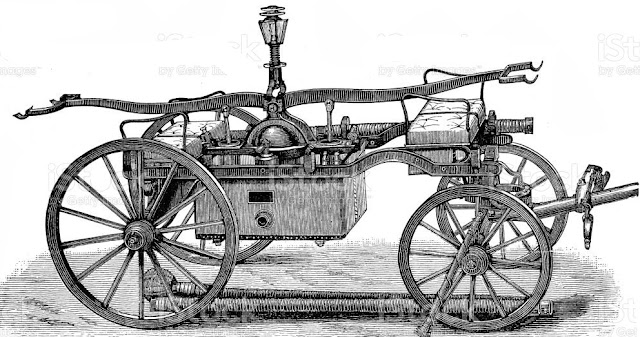In February 1855, a deep-toned bell was installed in the new Courthouse.
The July 1855 ordinance passed, dividing the City into six fire districts. An alarm-sounding code was initiated:
Mr. Holden, from the Committee on Fire and Water, made a report in regard to a system of Fire Alarms. The South, West and North Divisions are numbered 1, 2, and 3. The city is divided into 6 districts.
- One tap, followed by nine more taps, calls the firemen to district № 1.
- Three taps, followed by nine other taps, calls them to district № 3.
- Six taps, followed by nine other taps, calls them to district № 6.
- Six strokes of the bell calls out that part of the fire department which is located in the district in which the fire breaks out, thus:
- One tap followed by six others, Division № 1 to District № 1.
- 2-6, calls Division № 1 to District № 2.
- 3-6, calls Division № 2 to District № 3.
- 4-6, calls Division № 2 to District № 4.
- 5-6, calls Division № 3 to District № 5.
- 6-6, calls Division № 3 to District № 6.
- The Courthouse bell is also to designate the hours of 7, 12, 1, 6, and 9 o'clock by two taps an indefinite number of times.
- The report was laid on the table and ordered to be printed.
A watchman was continually on duty in the tower. Besides ringing the bell, the watchman was responsible for handing out flags by day and lanterns by night, used to direct firefighters to the fire scene. There was no gas in those days, so torch boys ran ahead of the engine to light the way. When an alarm was rung at night, citizens were responsible for placing lighted candles in their windows, lighting the way for the firefighters.
The "Long John" steam fire engine tested in February 1858 was met with hostility from the volunteer firemen. The volunteers could sense this was the beginning of their extinction. The steam engine "Long John" was put into service on May 1, 1858, at the corner of Adams and Franklin Street.
 |
| This Daguerreotype photograph was taken on July 4, 1855. The third floor and dome were not added to the Courthouse until 1858. The basement was above ground. |
Firefighters of the volunteer hose companies and two paid members, the engineer and assistant engineer, manned the "Long John." The death knell of the volunteer fire department was rung on August 2, 1858, when the city council passed the ordinance organizing the paid City of Chicago Fire Department. The first completely paid company was Engine Company № 3, located at 225 South Michigan Boulevard. This company was one of fifteen engines and three hook and ladder companies acquired from the volunteer department.
ADDITIONAL ARTICLES:
Compiled by Dr. Neil Gale, Ph.D.



